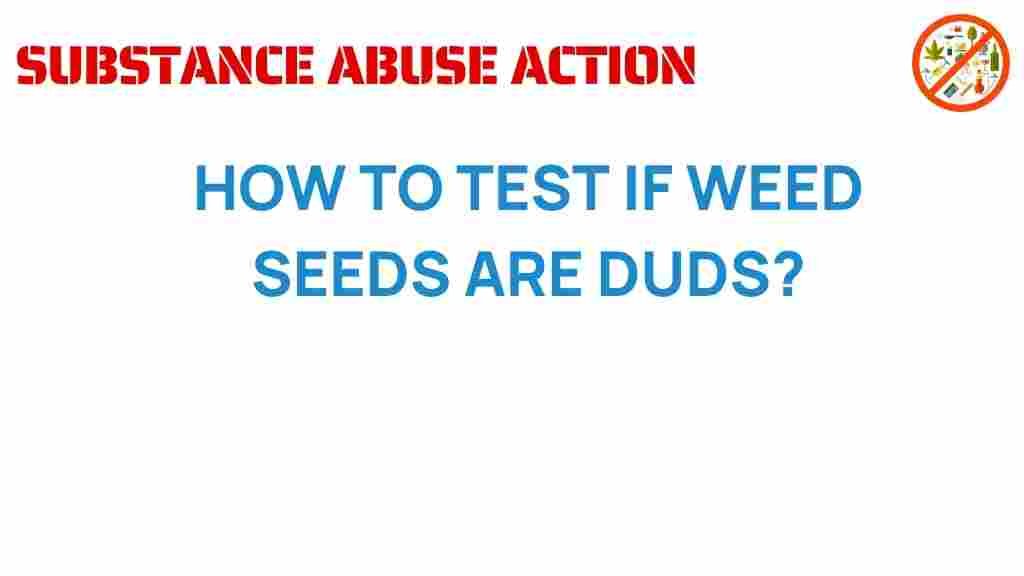Unveiling the Secrets: How to Test if Weed Seeds are Dud Seeds
Growing cannabis can be a rewarding venture, but it all starts with the quality of your weed seeds. If you’ve been cultivating for a while or are just starting, you might have encountered dud seeds—those that simply don’t germinate or produce weak plants. Understanding how to test your seeds is crucial for successful cultivation. In this guide, we will explore the methods to identify dud seeds and ensure that your gardening efforts yield fruitful results.
The Importance of Quality Weed Seeds
The first step in a successful cannabis garden is selecting high-quality weed seeds. Not all seeds are created equal; some may be old, improperly stored, or genetically inferior. Understanding how to recognize and test for dud seeds can save you time, money, and frustration.
What Are Dud Seeds?
Dud seeds are seeds that fail to germinate or produce weak, unhealthy plants. These seeds may be discolored, damaged, or simply lack the viability necessary for growth. Identifying these seeds early in your seed testing process can significantly enhance your chances of a successful harvest.
Step-by-Step Process to Test Weed Seeds
Testing your weed seeds for viability is a simple process that can be done at home. Here’s how to do it:
1. Visual Inspection
Before any germination tests, start with a visual inspection of your weed seeds. Look for:
- Color: Healthy seeds should be dark brown or black. Pale or green seeds may be immature or dud.
- Size: Larger seeds tend to be more viable than smaller ones.
- Surface Condition: Look for cracks or deformities. Seeds should be smooth and intact.
2. Float Test
Another method to identify dud seeds is the float test. This is a simple way to check seed viability:
- Add the seeds to the water.
- Wait for 15-30 minutes.
Results:
- Seeds that sink are likely viable.
- Seeds that float on the surface are likely dud seeds.
3. Germination Test
A germination test is the most reliable method to determine seed viability. Here’s how to perform it:
- Take a paper towel and moisten it with water.
- Place your weed seeds on the towel, spaced apart.
- Fold the towel over the seeds and place it in a warm, dark area.
- Check daily for moisture and ensure the towel stays damp but not wet.
Results:
- After 3-7 days, check for sprouting.
- If the seeds have germinated, they are viable.
- If no seeds sprout after 7 days, they may be dud seeds.
4. Soil Germination Test
If you prefer a more traditional approach, you can test the seeds directly in soil:
- Plant a few seeds in a small pot filled with good-quality potting soil.
- Water them lightly and place them in a warm, light area.
- Observe for signs of germination over the next couple of weeks.
Results: If the seeds don’t germinate within two weeks, they are likely dud seeds.
Troubleshooting Tips for Seed Testing
Even with the best practices, sometimes seeds may not germinate as expected. Here are some troubleshooting tips:
1. Check Your Environment
Make sure your environment is conducive to germination:
- Temperature: Most cannabis seeds germinate best at temperatures between 70°F and 85°F (21°C – 29°C).
- Humidity: Maintain a humid environment, especially during the initial germination phase.
- Light: Seeds don’t need light to germinate but should be placed in a bright, warm spot once they sprout.
2. Seed Storage Conditions
How you store your weed seeds can affect their viability:
- Keep seeds in a cool, dark, and dry place.
- Avoid exposing them to direct sunlight or moisture, which can lead to mold or degradation.
3. Seed Age
Understand that older seeds may have lower germination rates:
- Seeds stored for more than two years may have reduced viability.
- Consider purchasing fresh seeds from reputable suppliers for better results.
Conclusion
Testing your weed seeds for viability is an essential step in the cultivation of cannabis. By following the methods outlined above, you can identify dud seeds and ensure that your gardening efforts are fruitful. Remember that the quality of your seeds directly impacts the health of your plants, so invest the time in proper seed testing.
For further reading on cannabis cultivation techniques, check out this comprehensive guide. Additionally, if you’re interested in joining a community of gardeners, consider visiting this horticulture forum for tips and insights from fellow enthusiasts.
Happy gardening!
This article is in the category Health and created by SubstanceAbuseAction Team
